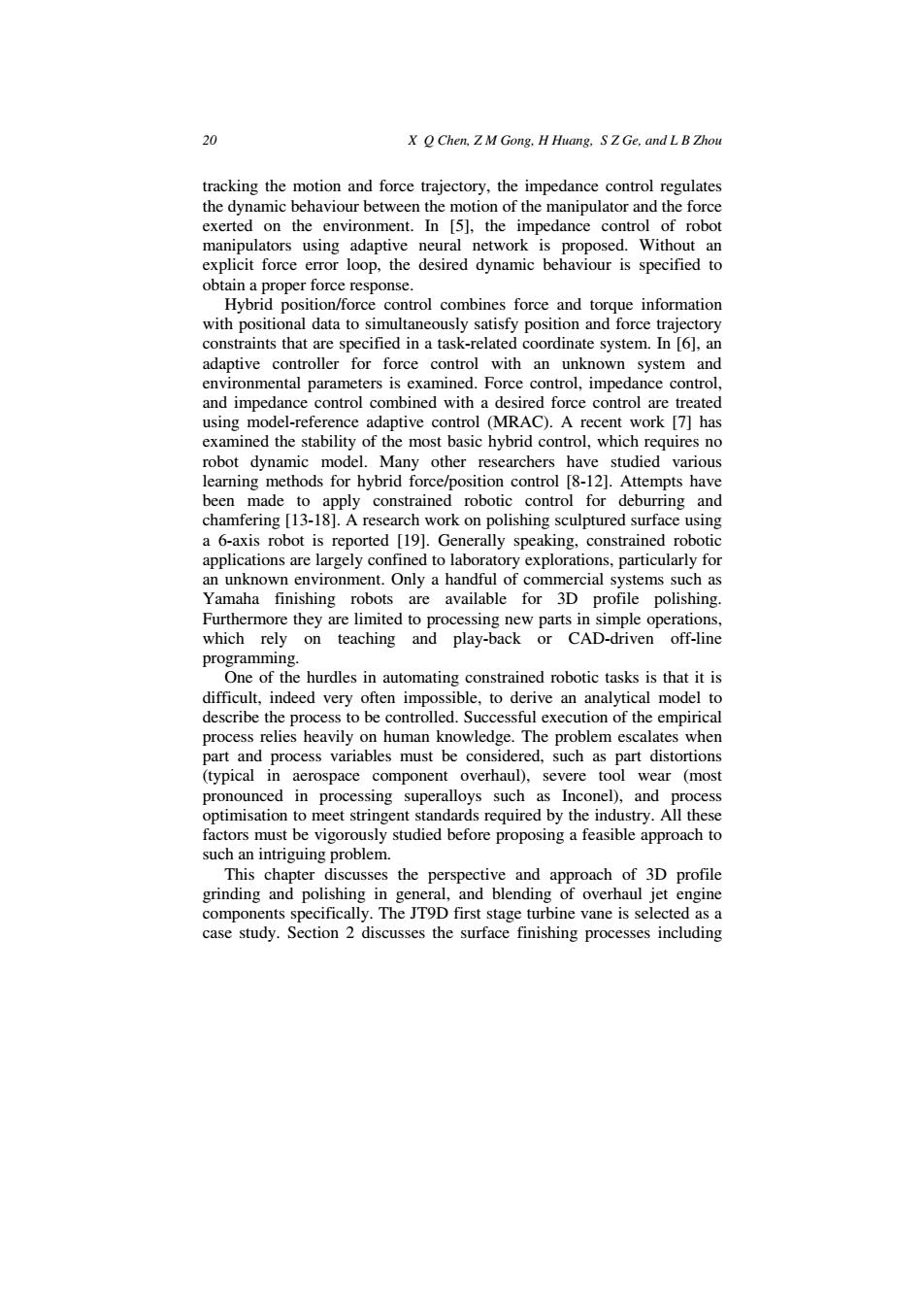正在加载图片...

20 X O Chen,Z M Gong,H Huang,S Z Ge,and L B Zhou tracking the motion and force trajectory,the impedance control regulates the dynamic behaviour between the motion of the manipulator and the force exerted on the environment.In [5],the impedance control of robot manipulators using adaptive neural network is proposed.Without an explicit force error loop,the desired dynamic behaviour is specified to obtain a proper force response. Hybrid position/force control combines force and torque information with positional data to simultaneously satisfy position and force trajectory constraints that are specified in a task-related coordinate system.In [6,an adaptive controller for force control with an unknown system and environmental parameters is examined.Force control,impedance control, and impedance control combined with a desired force control are treated using model-reference adaptive control (MRAC).A recent work [7]has examined the stability of the most basic hybrid control,which requires no robot dynamic model.Many other researchers have studied various learning methods for hybrid force/position control [8-12].Attempts have been made to apply constrained robotic control for deburring and chamfering [13-18].A research work on polishing sculptured surface using a 6-axis robot is reported [19].Generally speaking,constrained robotic applications are largely confined to laboratory explorations,particularly for an unknown environment.Only a handful of commercial systems such as Yamaha finishing robots are available for 3D profile polishing. Furthermore they are limited to processing new parts in simple operations, which rely on teaching and play-back or CAD-driven off-line programming. One of the hurdles in automating constrained robotic tasks is that it is difficult,indeed very often impossible,to derive an analytical model to describe the process to be controlled.Successful execution of the empirical process relies heavily on human knowledge.The problem escalates when part and process variables must be considered,such as part distortions (typical in aerospace component overhaul),severe tool wear (most pronounced in processing superalloys such as Inconel),and process optimisation to meet stringent standards required by the industry.All these factors must be vigorously studied before proposing a feasible approach to such an intriguing problem. This chapter discusses the perspective and approach of 3D profile grinding and polishing in general,and blending of overhaul jet engine components specifically.The JT9D first stage turbine vane is selected as a case study.Section 2 discusses the surface finishing processes including20 X Q Chen, Z M Gong, H Huang, S Z Ge, and L B Zhou tracking the motion and force trajectory, the impedance control regulates the dynamic behaviour between the motion of the manipulator and the force exerted on the environment. In [5], the impedance control of robot manipulators using adaptive neural network is proposed. Without an explicit force error loop, the desired dynamic behaviour is specified to obtain a proper force response. Hybrid position/force control combines force and torque information with positional data to simultaneously satisfy position and force trajectory constraints that are specified in a task-related coordinate system. In [6], an adaptive controller for force control with an unknown system and environmental parameters is examined. Force control, impedance control, and impedance control combined with a desired force control are treated using model-reference adaptive control (MRAC). A recent work [7] has examined the stability of the most basic hybrid control, which requires no robot dynamic model. Many other researchers have studied various learning methods for hybrid force/position control [8-12]. Attempts have been made to apply constrained robotic control for deburring and chamfering [13-18]. A research work on polishing sculptured surface using a 6-axis robot is reported [19]. Generally speaking, constrained robotic applications are largely confined to laboratory explorations, particularly for an unknown environment. Only a handful of commercial systems such as Yamaha finishing robots are available for 3D profile polishing. Furthermore they are limited to processing new parts in simple operations, which rely on teaching and play-back or CAD-driven off-line programming. One of the hurdles in automating constrained robotic tasks is that it is difficult, indeed very often impossible, to derive an analytical model to describe the process to be controlled. Successful execution of the empirical process relies heavily on human knowledge. The problem escalates when part and process variables must be considered, such as part distortions (typical in aerospace component overhaul), severe tool wear (most pronounced in processing superalloys such as Inconel), and process optimisation to meet stringent standards required by the industry. All these factors must be vigorously studied before proposing a feasible approach to such an intriguing problem. This chapter discusses the perspective and approach of 3D profile grinding and polishing in general, and blending of overhaul jet engine components specifically. The JT9D first stage turbine vane is selected as a case study. Section 2 discusses the surface finishing processes including